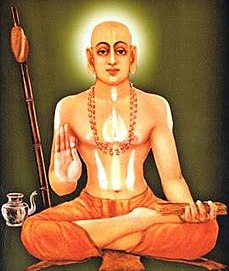Satyasandha Tirtha
Satyasandha Tirtha (Śrī Satya-sandha Tīrtha) (died 1794), was a Hindu philosopher, scholar, mystic and saint. He was the 26th pontiff of Uttaradi Math and served the pontificate from 1783-1794.[1]
Sri Satyasandha Tirtha | |
|---|---|
| Personal | |
| Born | Haveri Ramacharya |
| Died | 1794 |
| Resting place | Mahishi, Karnataka |
| Religion | Hinduism |
| Order | Vedanta (Uttaradi Math) |
| Philosophy | Dvaita Vedanta |
| Religious career | |
| Guru | Satyabodha Tirtha |
| Successor | Satyavara Tirtha |
| Part of a series on |
| Dvaita |
|---|
 |
|
Literature
|
|
|
Holy places |
| Hinduism portal |
Works
Most of the information about his life is derived from two hagiographies, Sri Satyasandha Vijaya by Koneratmaja and Guruvamsakathakalpatharu by Bhimadhaivajna.[2] Satyasandha Tirtha is an author of one commentary, and one praise-poem, both his works are most revered among Madhwa community. His Viṣṇusahasranāmabhāṣya is a commentary on Vishnu Sahasranama. His another work is Vishnu Stuti, a praise-poem on Lord Vishnu.[3][4][5]
In culture
Sri Satyasandha Vijaya, is a story of the victory and biography of Satyasandha Tirtha authored by Koneratmaja. He was entombed with his living body and is believed to be alive in the Brindavana even today. A very marvellous incident is graphically described in Satyasandha Vijaya about his being alive in the Brindavana many many years after his entrance into it.[6]
References
- Sharma 2000, p. 209.
- Bhatta, Samuel & John, p. 117.
- Sharma 2000, p. 508.
- Sharma 2000, p. 653.
- Upadhye 1973, p. 439.
- Gonda 1974, p. 417.
Bibliography
- Sharma, B. N. Krishnamurti (2000). A History of the Dvaita School of Vedānta and Its Literature, Vol 1. 3rd Edition. Motilal Banarsidass (2008 Reprint). ISBN 978-8120815759.CS1 maint: ref=harv (link)
- Glasenapp, Helmuth von (1992). Madhva's Philosophy of the Viṣṇu Faith. Dvaita Vedanta Studies and Research Foundation.CS1 maint: ref=harv (link)
- Gonda, Jan (1974), A History of Indian literature, Volume 9, Issues 1-4, Harrassowitz, ISBN 978-3447015608CS1 maint: ref=harv (link)
- Bhatta, C. Panduranga; Samuel, G. John; Hikosaka, Shu (1997). Contribution of Karṇāṭaka to Sanskrit. Institute of Asian Studies.CS1 maint: ref=harv (link)
- Upadhye, A. N. (1973). Journal of Indian History, Volume 51. Department of History, University of Kerala.CS1 maint: ref=harv (link)